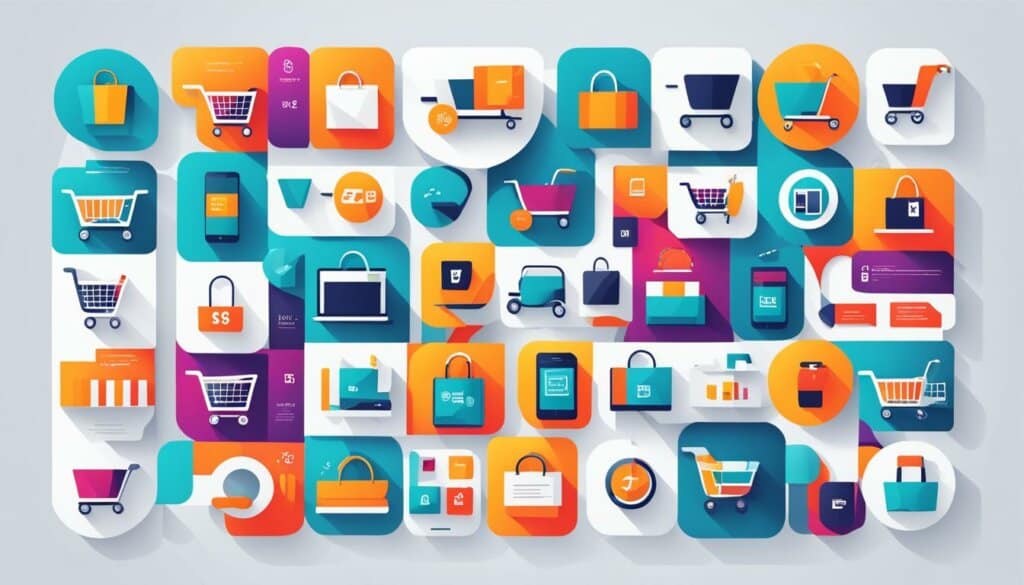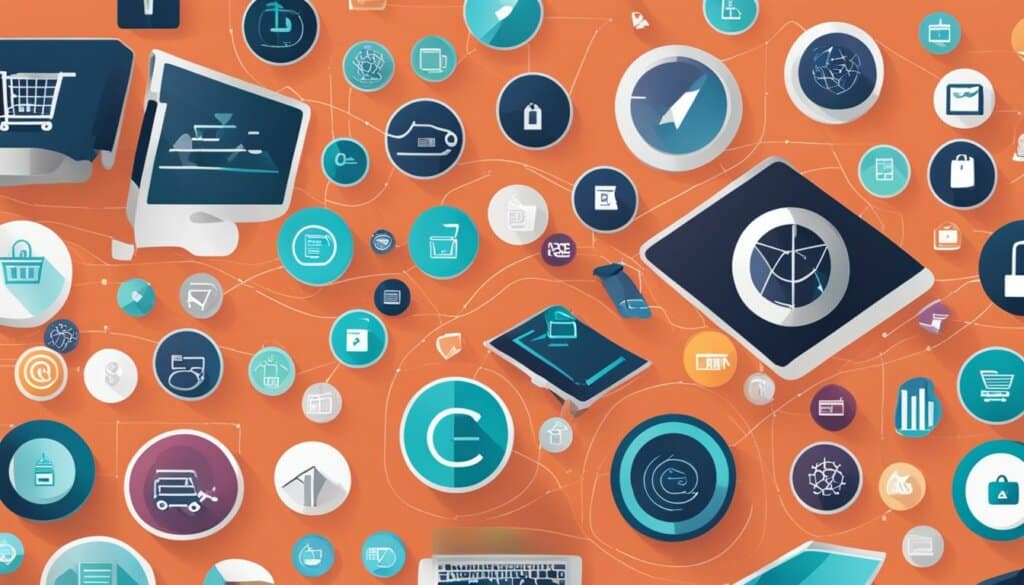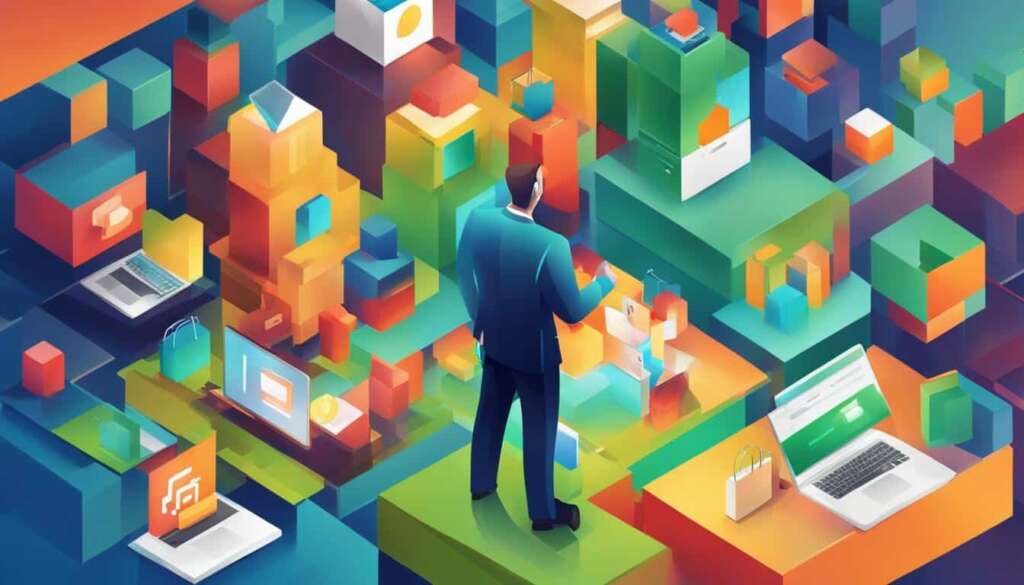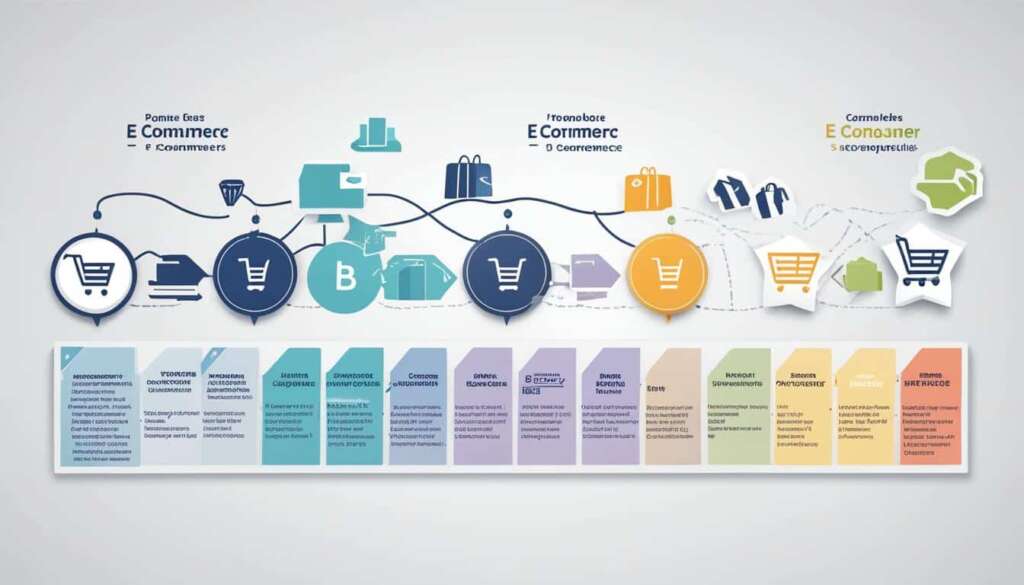Table of Contents
E-commerce, or electronic commerce, is the process of buying and selling goods and services online. It has become an integral part of modern business, revolutionizing the way we shop and conduct transactions. In this article, we will explore the definition and scope of e-commerce, discussing its various types, advantages, and disadvantages.
E-commerce encompasses a wide range of transactions conducted over electronic networks, primarily the internet. It involves interactions between businesses (B2B), businesses and consumers (B2C), consumers and other consumers (C2C), and consumers and businesses (C2B).
Major e-commerce platforms, such as Amazon and eBay, have played a significant role in the growth of online retail. They provide a convenient and accessible marketplace for sellers and buyers from around the world.
The COVID-19 pandemic has further accelerated the shift towards e-commerce, with online sales accounting for a considerable percentage of total retail sales. This trend highlights the importance of understanding and harnessing the potential of e-commerce in today’s digital landscape.
E-commerce offers numerous advantages, including 24/7 availability, global reach, lower operating costs, and personalized marketing. However, it also has its drawbacks, such as limited customer service, the inability to physically assess products before purchase, and security concerns.
In the following sections, we will delve deeper into how e-commerce works, the different types of e-commerce, its advantages and disadvantages, and the key factors businesses need to consider to thrive in the digital marketplace.
How Does E-Commerce Work?
E-commerce, or electronic commerce, relies on the internet as the primary platform for conducting business transactions. Customers utilize their devices to access online stores, browse through a wide range of products, and place orders. The process of e-commerce involves various stages, including order management, inventory management, and payment processing.
When a customer places an order, their web browser establishes communication with the server hosting the e-commerce website. This communication pathway allows the customer’s data to be relayed to different components of the e-commerce system, such as the order manager, inventory management databases, payment processing applications like PayPal, and the bank.
Once the order is validated and confirmed, the order manager takes charge of the process. It notifies the web server, which displays a message to the customer, acknowledging the successful placement of the order. Subsequently, the order data is transmitted to the warehouse or fulfillment department, where appropriate actions are taken to ensure the prompt dispatch of tangible products or the granting of access to digital services.
In the case of physical products, they are shipped to the customer’s designated address. On the other hand, for digital products or services, access is granted immediately, allowing customers to benefit from the purchased offerings without any physical shipment involved.
| Key Components of E-Commerce | Description |
|---|---|
| Order Management | The process of receiving and processing customer orders, ensuring swift and efficient handling. |
| Inventory Management | The management of available stocks or digital assets, ensuring accurate tracking of product availability, restocking processes, and monitoring supply and demand patterns. |
| Payment Processing | The secure handling of financial transactions, verification of payment details, and transfer of funds between the customer, e-commerce platform, and relevant financial institutions. |
E-commerce has introduced convenience and efficiency into the retail market. Customers can explore a vast array of products and services from the comfort of their own homes, while businesses can reach a global customer base without the limitations of physical locations. The seamless integration of order management, inventory management, and payment processing ensures a smooth and satisfying experience for both customers and businesses in the e-commerce ecosystem.
Types of E-Commerce
E-commerce involves various types of transactions, each catering to specific market segments and serving distinct purposes. Let’s explore the key types of e-commerce:
B2B E-Commerce
In B2B e-commerce, businesses engage in transactions with other businesses. This type of e-commerce facilitates the exchange of goods, services, or information between companies. B2B e-commerce is often characterized by large-scale purchases, long-term contracts, and specialized products or services.
B2C E-Commerce
B2C e-commerce focuses on businesses selling products or services directly to consumers. It is one of the most common forms of e-commerce, enabling companies to reach and serve a wide range of individual customers. B2C e-commerce offers convenience, product variety, and personalized shopping experiences to consumers.
C2C E-Commerce
C2C e-commerce involves consumers trading products, services, or information with each other through online platforms. This type of e-commerce creates a peer-to-peer marketplace, where individuals can buy and sell items directly without the involvement of businesses. Popular examples of C2C e-commerce platforms include eBay and Etsy.
C2B E-Commerce
C2B e-commerce is when consumers make their products or services available online for businesses to purchase. This type of e-commerce allows individuals to monetize their skills, expertise, or personal assets by offering them to companies in need. Freelance platforms and influencer marketing are common examples of C2B e-commerce.
Other types of e-commerce include business-to-administration (B2A) and consumer-to-administration (C2A) transactions. B2A e-commerce involves online transactions between businesses and government organizations, while C2A e-commerce refers to interactions between consumers and government entities. Mobile commerce (m-commerce) is another important category, encompassing e-commerce activities conducted through mobile devices.
Understanding the different types of e-commerce helps businesses determine the most suitable strategies and platforms to reach their target audiences and achieve their goals.

Advantages of E-Commerce
E-commerce offers several benefits that contribute to the growth and success of businesses. From global marketing reach to lower operating costs, here are some of the advantages of engaging in e-commerce:
1. Global Marketing Reach
One of the significant advantages of e-commerce is the ability to reach customers anywhere in the world. With an online store, businesses can break geographic barriers and expand their customer base internationally. This global marketing reach opens up vast opportunities for businesses to tap into new markets and increase sales.
2. Lower Operating Costs
Compared to traditional brick-and-mortar stores, e-commerce significantly reduces operating costs for businesses. It eliminates the need for expenses such as rent, utilities, and inventory management. Additionally, with fewer staff required for running a physical store, businesses can save on staffing costs, including wages and benefits. E-commerce streamlines operations, leading to more efficient resource allocation and ultimately lower costs.
3. Convenience
E-commerce provides convenience for both businesses and customers. Customers can browse and purchase products or services online at any time, eliminating the need to visit a physical store during regular business hours. This convenience factor enhances the overall shopping experience, allowing customers to shop at their own pace without any time constraints. Businesses, on the other hand, can operate 24/7, catering to customers around the clock without limitations.
4. Easier Management
Managing an e-commerce business is often easier compared to traditional retail. With e-commerce platforms and tools, businesses can efficiently track sales, manage inventory, and analyze customer data for personalized marketing strategies. The availability of real-time data and insights allows businesses to make informed decisions, optimize operations, and tailor their strategies to meet customer demands effectively.
5. Wide Selection of Products
Online stores offer a vast selection of products to customers, often exceeding the options available in physical stores. Businesses can showcase their entire inventory, allowing customers to explore an extensive range of products or services. Additionally, e-commerce enables businesses to curate personalized product recommendations for customers based on their browsing and purchase history, enhancing the overall shopping experience.
E-commerce presents numerous benefits that empower businesses to reach a global audience, reduce costs, provide convenience, streamline management processes, and offer a wide range of products. These advantages have contributed to the widespread adoption of e-commerce as a powerful and lucrative business model.
| Advantages of E-Commerce | Description |
|---|---|
| Global Marketing Reach | Expand customer base internationally |
| Lower Operating Costs | Eliminate expenses associated with physical stores |
| Convenience | 24/7 accessibility for customers |
| Easier Management | Efficient tracking, inventory management, and data analysis |
| Wide Selection of Products | Greater variety and personalized recommendations |
Disadvantages of E-Commerce
E-commerce, while offering numerous benefits, also comes with its fair share of drawbacks. It is important for businesses and customers alike to be aware of these limitations to make informed decisions when engaging in online transactions.
Limited Customer Service
One of the key limitations of e-commerce is the lack of personalized customer service. Unlike traditional brick-and-mortar stores, where customers can seek immediate assistance from sales associates or customer service representatives, e-commerce platforms often rely on automated systems or email communication for customer support. This limited interaction can lead to delays in resolving issues and a less satisfying shopping experience for some consumers.
Lack of Product Experience
Another disadvantage of e-commerce is the inability for customers to physically touch, try on, or experience products before making a purchase. This can be a major drawback, particularly when it comes to buying items like clothing or furniture, where fit, texture, or quality are important considerations. The lack of firsthand experience with the products can sometimes result in mismatched expectations, leading to customer dissatisfaction and potentially higher return rates.
Wait Time for Product Delivery
E-commerce typically involves a wait time between placing an order and receiving the product. While advancements in shipping and logistics have significantly reduced delivery times compared to the early days of e-commerce, customers still need to wait for their purchases to arrive. This can be a source of frustration, especially when quick access to products is desired, as in the case of last-minute gifts or urgent needs.
Security Concerns
A crucial concern in the world of e-commerce is security. Customers have to share personal and financial information during online transactions, making them vulnerable to potential data breaches and fraudulent activities. While e-commerce platforms implement various security measures, it’s essential for both businesses and customers to prioritize data protection and stay vigilant against potential threats.
Despite its advantages, e-commerce also has its fair share of disadvantages. Limited customer service, lack of product experience, wait time for product delivery, and security concerns are some of the factors that customers and businesses need to consider when engaging in online transactions.
While these limitations exist, it’s worth noting that the evolution of e-commerce continues to drive innovation, with businesses and platforms continually working to address these challenges. By staying informed and taking necessary precautions, both businesses and customers can navigate the e-commerce landscape effectively.
| Disadvantages of E-commerce |
|---|
| Limited Customer Service |
| Lack of Product Experience |
| Wait Time for Product Delivery |
| Security Concerns |
Major Types of E-Commerce
E-commerce encompasses various types of transactions conducted online. The major types of e-commerce are B2C, B2B, C2C, and C2B. Each type serves different market segments and requires specific strategies and considerations.
B2C E-Commerce: Businesses Selling to Consumers
B2C e-commerce involves businesses selling products or services directly to consumers. This type of e-commerce is prevalent in online retail, where companies like Amazon and ASOS offer a wide range of products to individual customers. B2C e-commerce often focuses on creating user-friendly websites, providing a seamless shopping experience, and implementing effective digital marketing strategies to attract and engage consumers.
B2B E-Commerce: Transactions Between Businesses
B2B e-commerce refers to transactions between businesses, where one business sells its products or services to another. This type of e-commerce is common in industries such as manufacturing, wholesale, and professional services. B2B e-commerce platforms enable businesses to streamline procurement processes, negotiate pricing and contracts, and efficiently manage large-scale transactions. Examples of B2B e-commerce platforms include Alibaba.com and Thomasnet.
C2C E-Commerce: Consumer-to-Consumer Transactions
C2C e-commerce involves consumers trading products, services, or information with each other through online platforms. This type of e-commerce enables individuals to sell and purchase items directly from other individuals. Online marketplaces like eBay and Etsy facilitate C2C transactions, providing a platform for users to buy and sell a wide range of goods. C2C e-commerce often relies on user-generated content, peer-to-peer communication, and rating systems to build trust and facilitate successful transactions.
C2B E-Commerce: Consumers Selling to Businesses
C2B e-commerce refers to consumers selling their products or services to businesses. This type of e-commerce has gained popularity with the rise of the gig economy and freelance work. Platforms like Upwork and Fiverr allow individuals to offer their skills and expertise to businesses seeking specific services. C2B e-commerce provides opportunities for individuals to monetize their talents and find clients globally.
| E-Commerce Type | Description | Examples |
|---|---|---|
| B2C | Businesses selling directly to consumers | Amazon, ASOS |
| B2B | Transactions between businesses | Alibaba.com, Thomasnet |
| C2C | Consumer-to-consumer transactions | eBay, Etsy |
| C2B | Consumers selling to businesses | Upwork, Fiverr |

Conclusion
In conclusion, e-commerce has transformed the business landscape and revolutionized the way consumers shop. With its wide range of opportunities, businesses are able to expand their reach, boost sales, and streamline operations, resulting in reduced operating costs. The growth of e-commerce can be attributed to advancements in technology and the increasing preference for online shopping.
However, it’s important to acknowledge that e-commerce is not without its limitations. Limited customer service is a notable drawback, as face-to-face interactions are minimized. Additionally, customers may miss out on the tactile experience of physically examining products before purchasing. Security concerns, although being addressed, pose a potential risk that businesses and consumers must remain vigilant against.
Overall, a thorough understanding of the different types of e-commerce and how it functions is crucial for businesses to thrive in the digital marketplace. By harnessing the advantages of e-commerce, such as convenience, global marketing reach, and cost-effectiveness, businesses can unlock immense growth potential. It is imperative to address the limitations and mitigate associated risks to ensure a secure and seamless e-commerce experience for all stakeholders.
FAQ
What is e-commerce?
E-commerce refers to the buying and selling of goods and services over an electronic network, primarily the internet.
What are the major types of e-commerce?
The major types of e-commerce include B2C (business-to-consumer), B2B (business-to-business), C2C (consumer-to-consumer), and C2B (consumer-to-business) transactions.
How does e-commerce work?
When an order is placed, the customer’s web browser communicates with the server hosting the e-commerce website, relaying data to the order manager, inventory management databases, payment processing applications, and the bank. Once the order is validated, the order data is sent to the warehouse or fulfillment department for product dispatch.
What are the advantages of e-commerce?
E-commerce offers advantages such as 24/7 availability, global reach, lower operating costs, and personalized marketing.
What are the disadvantages of e-commerce?
Some disadvantages of e-commerce include limited customer service, inability to touch and try products before purchase, and security concerns.
What are the benefits of B2C e-commerce?
B2C e-commerce allows businesses to sell products or services directly to consumers, providing a global marketing reach, lower operating costs, and convenience for customers.
What are the limitations of e-commerce?
E-commerce has limitations such as limited customer service, the inability to physically experience products before purchase, wait time for product delivery, and security concerns.
What is the scope of e-commerce?
E-commerce offers businesses opportunities to expand their reach, increase sales, and reduce operating costs, while also revolutionizing the way consumers shop.













